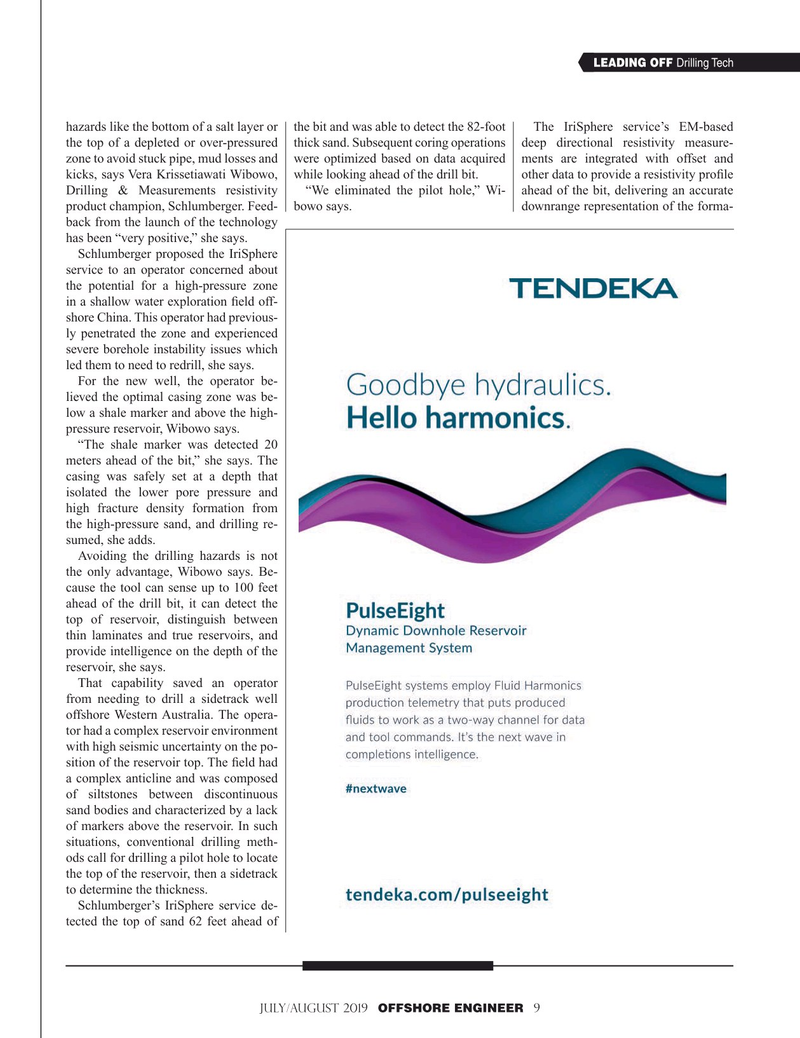
Page 9: of Offshore Engineer Magazine (Jul/Aug 2019)
Subsea Processing
Read this page in Pdf, Flash or Html5 edition of Jul/Aug 2019 Offshore Engineer Magazine
LEADING OFF Drilling Tech hazards like the bottom of a salt layer or the bit and was able to detect the 82-foot The IriSphere service’s EM-based the top of a depleted or over-pressured thick sand. Subsequent coring operations deep directional resistivity measure- zone to avoid stuck pipe, mud losses and were optimized based on data acquired ments are integrated with offset and kicks, says Vera Krissetiawati Wibowo, while looking ahead of the drill bit. other data to provide a resistivity pro? le
Drilling & Measurements resistivity “We eliminated the pilot hole,” Wi- ahead of the bit, delivering an accurate product champion, Schlumberger. Feed- bowo says. downrange representation of the forma- back from the launch of the technology has been “very positive,” she says.
Schlumberger proposed the IriSphere service to an operator concerned about the potential for a high-pressure zone in a shallow water exploration ? eld off- shore China. This operator had previous- ly penetrated the zone and experienced severe borehole instability issues which led them to need to redrill, she says.
For the new well, the operator be- lieved the optimal casing zone was be- low a shale marker and above the high- pressure reservoir, Wibowo says.
“The shale marker was detected 20 meters ahead of the bit,” she says. The casing was safely set at a depth that isolated the lower pore pressure and high fracture density formation from the high-pressure sand, and drilling re- sumed, she adds.
Avoiding the drilling hazards is not the only advantage, Wibowo says. Be- cause the tool can sense up to 100 feet ahead of the drill bit, it can detect the top of reservoir, distinguish between thin laminates and true reservoirs, and provide intelligence on the depth of the reservoir, she says.
That capability saved an operator from needing to drill a sidetrack well offshore Western Australia. The opera- tor had a complex reservoir environment with high seismic uncertainty on the po- sition of the reservoir top. The ? eld had a complex anticline and was composed of siltstones between discontinuous sand bodies and characterized by a lack of markers above the reservoir. In such situations, conventional drilling meth- ods call for drilling a pilot hole to locate the top of the reservoir, then a sidetrack to determine the thickness.
Schlumberger’s IriSphere service de- tected the top of sand 62 feet ahead of
JULY/AUGUST 2019 OFFSHORE ENGINEER 9

 8
8

 10
10